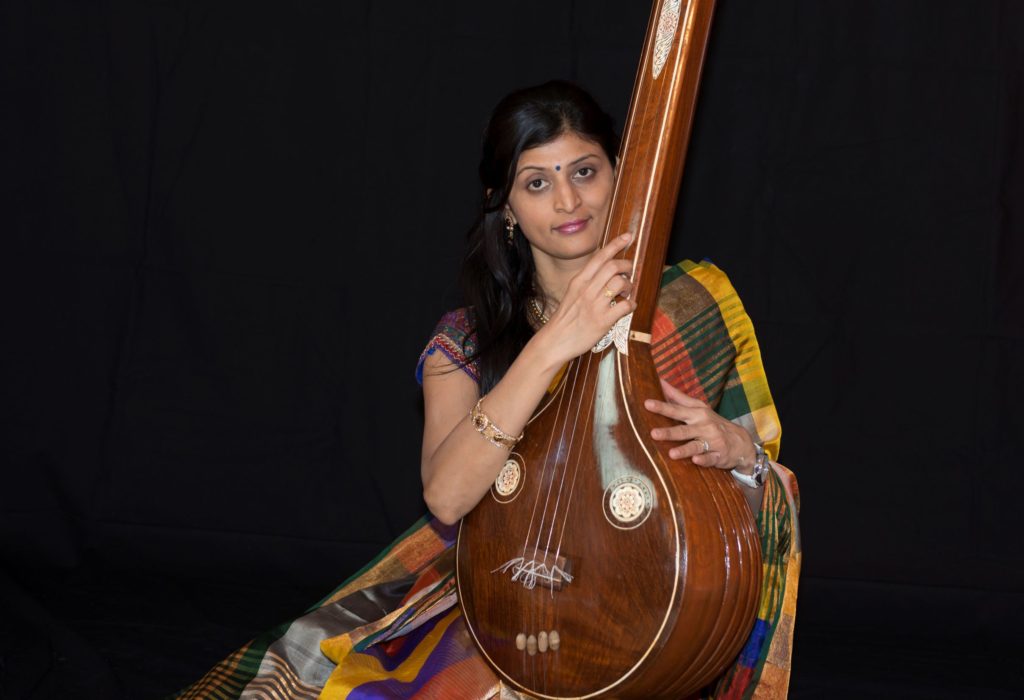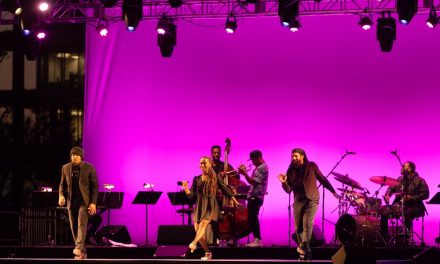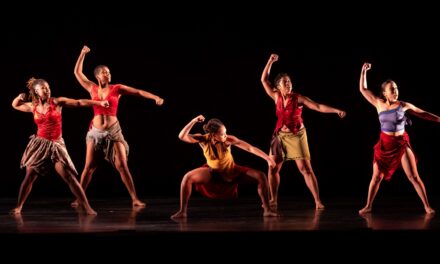An online Festival of Indian Dance and Music is not an easy thing to orchestrate, but Guru Sushma Mohan and her fellow artists did an admirable job. I encourage you to view the performances, and to cultivate a hunger to see and hear this remarkable art in person when that is possible. That is what the festival did for me.
The focus of this review is on the work of Bharatanatyam artists who were presented.
One attractive feature of this festival was the range of talent invited to present. We saw young adult student dancers and very experienced masters. All were fascinating to watch. All demonstrated the breadth of movement offered in the style – from quick percussive footwork to sweeping gestures, from carefully erect torsos to deep, broad bending, with precise hand gestures and expressive facial animation.
What differentiates the masters from the students? Of course, there are the time invested and the miles on the floor. The masters radiate a depth and subtlety that require meticulous attention to every detail of the music, history, styles, stories and symbols of the form. Their choices are carefully designed to draw us in, engage us emotionally, and to lift us up from our earthly constraints. Younger dancers tend to be more focused on the form, and are still learning to allow the dance, symbol, and story to inhabit the entire body and soul. That comes with time.
Rukmini Sandesham, the story of princess Rukmini and her love with the god Krishna.
Music, Choreography and Concept: Sushma Mohan
Original score: Vidwan H S Venugopal
Nattuvangam: Guru Pulikeshi Kasturi
Vocal: Deepthi Srinath
Veena: Gopal
Mridangam: Vidwan G G Gurumurthy
Flute: H S Venugopal
The tale comes from the ancient Hindu text Srimad Bhaagavatha, and is replete with young love, a scheming brother, heroic Krishna, and weddings. The performance by Sushman Mohan showed the breadth of expression that comes from a lifetime of immersion.
Mohan gave herself to every detail, starting with the feet and moving all the way through the body. She was in control of each stepping – whether short or long – with a combination of soft, full contact with the floor and percussive precision. Weight shifts were firm and clear, and every gesture had purpose. Because the nature of this dance form is grounded, a moment when the lower leg flicks up in the back becomes a moment of dynamic change. Each hand gesture – down to the fingertip – was filled with energy and precision, telling the story and inviting us to follow along. Positions and angles of the head and torso were expressive, and her facial expressions were nuanced yet boldly clear. Bold enough to be read from a distance, nuanced to express a full conversation or a single emotion.
Her ability to carry the story from one scene to another was clear and charming. Her movement choices, her face and everything in between helped us travel from one situation to another. She was a happy wedding attendee, a beautiful romantic princess, a frightened and betrayed sister, and a blissful bride.
In Praise of Lord Murugan – Danced by Aishwarya Raman.
Choreography: Aishwarya Raman
Raman is a dancer with a degree in Baratanatyam as well as advanced studies in bioengineering. She brings her prodigious brain to her dance in praise of Lord Murugan, son of Parvati and Shiva, brother of Ganesha. Murugan represents the power of wisdom and is the protector of humanity. As commander of all diving forces, he eliminates evils. Prayers to Murugan request resolution of problems, and he is often represented with his mount, a peacock.
Raman has an assured presence, and all the sculptural precision demanded by the form. Her feet make full contact with the floor when she steps, and she articulates deftly during percussive moments. Hand/arm gestures are explicit and detailed. When Roman reaches out she is fully extended, when she gathers herself afterward, her energy is tightly contained. Her face is expressive, sharing the emotion of the moment with us, and sometimes turning inward. The dance is an offering, and the gestures of giving and receiving range from broad sweeps through space to intimate hand and finger motion.
Story of Vamana and Bali – Danced by Aishwarya Raman
Raman presented a narrative that is focused on feet, as described in the story of diminutive Vamana beseeching the demon king Bali for land – that he might step over in 3 paces. Little did Bali know, when he laughingly agreed, that Vamana would assume a gigantic form and assume the earth, and the midworld. The third step on Bali’s head send the demon to the underworld.
This narrative had deeply sculptural gestures, and dramatic changes of level – from standing to sitting and even lying on the floor. A big story calls for big movement. Always exciting in Bharatanatyam, there were brief moments with jumps and hops. We saw fists in punching and swinging motion. There was traveling throughout the space using different types of stepping – from small pattering to lengthy strides. When she sat on the floor with knees wide, we felt her with deep attention to gestures of the hands and arms, beseeching. This work closed with Raman lying on her stomach, with her arms over head. Vamana had subdued Bali.
Deepti Mukund Navile and Natya Bumi, co-directors of Natyabhoomi School of Dance, in Potomac and Gaithersburg, MD, presented the next works in the program:
Narasimha – Vishnu – Danced by Tanvi Navile
Narasimha, known as the great protector, was incarnated in the form of half lion, half man, to destroy evil and restore Dharma. Like other Hindu gods, he must employ very clever strategy to achieve his goal of destroying an evil demon, Hiranyakashipu.
The work opens with the dancer in a deep squat, making gestures of offering. After standing and bowing, the sculpture becomes motion. A high, wide jump with knees lifted starts things with a bang. The traditional rhythmic foot patterns, gesturing arms and direction changes are more percussive than in the earlier works – a function of the Mysore style. Music comes not only from the accompaniment, but also from the feet and the bells worn on the ankles.
Poems –
Danced by Deepti Mukund Navile
The first poems are about the future of the temple envision sculpture brought to life. Krishna is puzzled – is this a ruse? The dancing is mature in the best possible way, deeply grounded footwork, with each movement resonating through the entire body. Navile embodies sculpture with figural changes – simple standing with the feet close together, hands on hips; a lunge with arms extended to the side from the shoulder and bent at the elbow; to a soft plie; arms quietly at the sides.
Danced by Tanvi Navile
The next poem is about the transformation of a child to an adult. Dancing behind a sheer golden veil, we see a smiling child. Her young face is exploring with her eyes as well as her body, stepping from side to side in the space. She discards the veil and the transformation begins with larger movement, deeper angles. As the footwork becomes more percussive, her face, eyes, and focus are more animated. This is a celebration!
Benediction: Ode for a Better World – Danced by Deepti Mukund Navile
In the spirit of prayer, this dance was an offering of the self, the body. Navile reached out, yet the movement was contained, reverent. Many gestures of open arms, handwashing and arching to the side created a sense of gentle kindness, exactly what we are hoping for in the new year.
Dr. Aparna Sindoor and Amil Natyaveda
Dr. Sindoor is another master of Bharatanatyam, specializing in the Mysore style. Her partner is a dancer, deeply engaged in Kalari “the mother of all martial arts” and is also an aerialist. Their work deeply honors ancient traditions and infuses them with creativity.
Their first work begins with a strong, atypical sculptural image with Dr. Sindoor chanting, walking forward, while Natyaveda is suspended from a rope hanging from the ceiling. She separates from him, chanting, lunging, and gesturing with her arms while holding fighting sticks. He spirals down from the rope and exits, re-entering the space with a leap. They face off from opposite corners in a slow dance duel of digging, striking and evading each other’s sticks.
The second work is a story of love and the offerings that come with it. This work had the energy and grounded feel of the Indian traditions, but was an artful duet blending styles of theatrical dance, partnering, and an aerial sculpture in motion. The partner touches and gestures had an exquisite tenderness.
The Los Angeles Indian Dance and Music Festival 2020 is a remarkable celebration of an ancient art form as expressed by an incredible array of today’s performing artists. It was not an easy undertaking. There were technical glitches that we experience daily in this moment. But the range of expression, the ultimate joy in sharing and exploring tradition, were the great gifts of this event. Please watch and listen.
Saturday, December 19, 2020, supported by Los Angeles County Department of Arts and Culture, and Department of Cultural Affairs – LA
Streamed online at www.youtube.com/sooryafoundation and www.facebook.com/sooryafoundation/
Available for viewing now
LA Dance Chronicle reached out to those in charge of the festival for a full list of choreographers and musicians but were told that such a list was not available. We apologize for not being able to give the proper notice to those artists.
Written by Mary Pat Cooney for LA Dance Chronicle.
Featured image: Guru Sushma Mohan – Photo courtesy of the artist.











